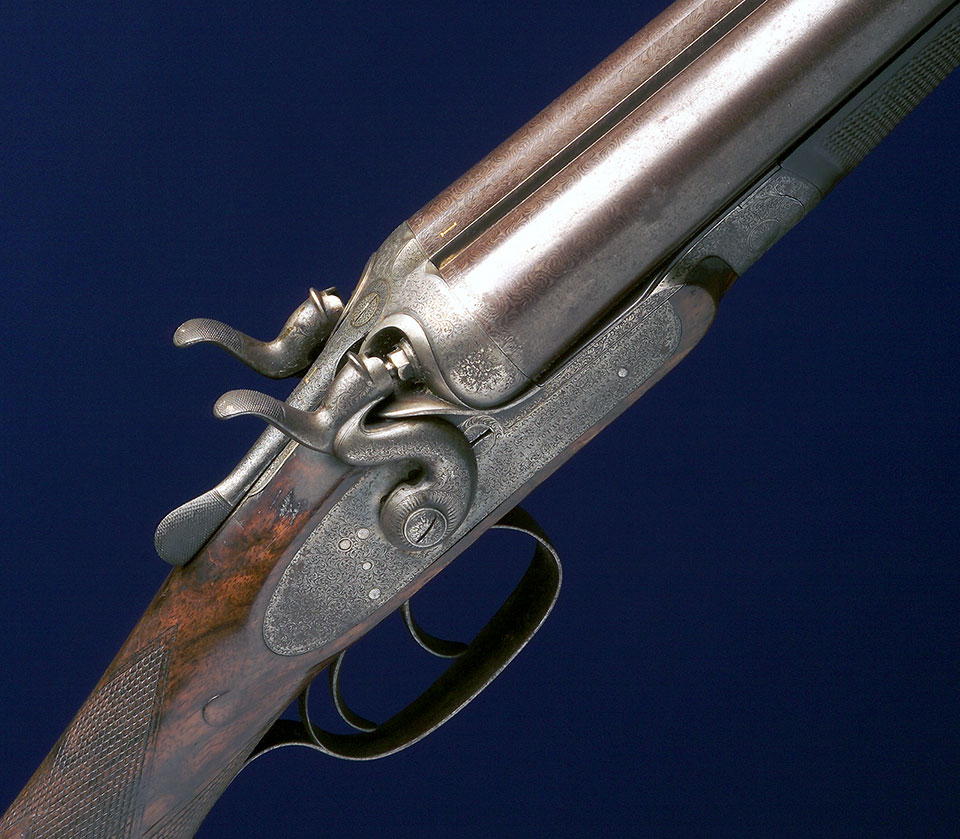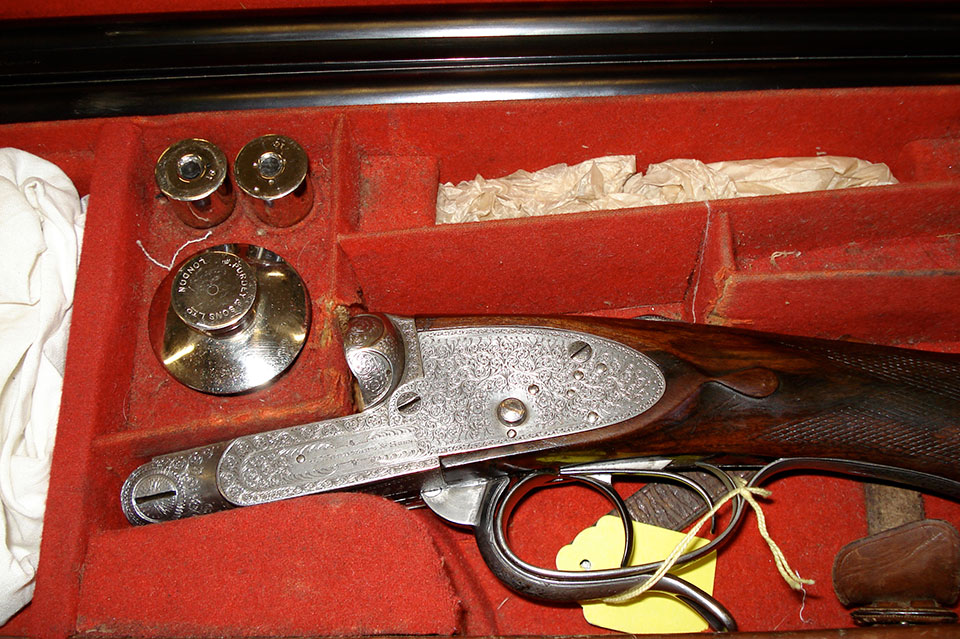The guns of James Woodward & Sons have always been prized for their quality, being described in 1900 as ‘first-class work’, equal in quality to Purdey’s output.
However, they were nowhere near as well known, and at least part of this can be attributed to the company’s relatively small output. When the company closed at the end of 1948, the highest number issued was No. 7148. This cannot be used as a definitive production figure though, as like Boss & Co. they issued unique serial numbers to extra and replacement barrels. There is then the issue of where their records start.
The first of the two Dimension Books nominally starts at No. 2000, but this only appears on the forty-third page. The previous forty-two pages are blank, and while serial numbers have been entered sporadically there are no completed entries until No. 2886. This means that it is impossible to know when the numbering sequence started, leaving the possibility that they continued that started by Moore & Woodward. It certainly appears to have started before the company became James Woodward & Sons, as the earliest dated entry, No. 3192, was sold in November 1871.
Before discussing the company’s early production, it is worth noting two things. The first is that Woodward’s records are extremely patchy. As noted above, nearly three thousand numbers are missing from the beginning of the sequence, and they remain sporadic until No. 3270. They become more consistent after No. 3383, although only the main dimensions were recorded until 1879, and No. 3708. From that point thereafter, the records include the dimensions and a brief description of the gun itself.

That is not to say that every gun is recorded, and gaps are found throughout the records. The second thing to consider is that, even where there are records, they can be frustratingly vague, particularly when it comes to engraving. For this reason, it is not possible to determine when their Victorian fine scroll pattern was replaced with the Purdey-style rose and scroll design, although from observed guns this appears to have happened in the first decade or so of the twentieth century. Even in the rare cases where an unusual pattern has been applied, only the briefest reference might be made, such as ‘Special Scroll’ or ‘Extra Full’ engraving.
A detailed examination of Woodward’s records reveals a remarkable variation in dates of sale. To return to the guns mentioned above, No. 2886 was sold in 1876, nearly five years after No. 3192. This may have something to do with the former being a ‘trials gun’, possibly using an action supplied by Aston, but no other information is given. In between these are two other entries which serve to demonstrate the sheer variety of Woodward’s production: No. 2935 (muzzle-loading 13½-Bore gun), sold in July 1874; No. 3137 (single-barrelled 12-Bore centrefire gun), sold a month earlier.
The spread in serial numbers also suggests that Woodward kept a large variety of either semi-completed or fully completed guns and rifles in hand, sometimes for years at a time. It also often happens to the earliest serial numbers of new actions. As an example, the lowest serial number where the gun is referred to as an ‘Automatic’ is No. 3470, which was sold in 1878. However, the entries around it were all completed in 1875, suggesting that this may be either a prototype and/or demonstrator. The ‘Automatic’ with the earliest sale date is No. 3509, which was bought in 1876.
The ’Automatic’ was Woodward’s most famous side-by-side action, using a patent registered jointly in 1876 by James Woodward Junior and one of the best-known inventors of that period; Thomas Southgate. This was the latter’s first patent, and it has been suggested that Southgate had served his apprenticeship with Woodward’s. The action was initially launched as a self-cocking hammer action, a style of action that they were advertising as early as 1869. However, while that earlier advertising had described a gun that was half-cocked when the lever was operated, Southgate’s design was pushed to full cock.

Despite this, they are usually not found with any form of safety fitted, meaning they are ‘live’ when the gun is closed which often worries modern buyers. This was not the case with the hammerless actions, which were fitted with the earliest examples of their characteristic ‘fish-tail’ safety-slide. It is notable how quickly the first hammerless ‘Automatic’, No. 3589, was produced, being sold at the end of 1877, although it did not earn its own review in The Field until April 1881. Early examples have dipped-edge lockplates, although the shape is more suggestive of a bar-action hammer lock modified to cover the tumbler and the hammer’s pivot finished as an early-form of Woodward’s distinctive ‘bug-eyed’ cocking-indicators.
These appear to have remained in use until the ‘Automatic’ model was discontinued, although it is not clear when that was. The last guns recorded as such in the Dimension Books, Nos. 4888/9, were sold in 1894, but ‘Automatic’ double rifles appear up until No. 5610, sold a decade later. Confusingly, at least two toplever guns, Nos. 5132 and 5314, bear the ‘Automatic’ stamp on the breech-face, although they do not appear to have been built on the patent, and the term continues to appear sporadically in the accounts ledgers as the model name for a best gun into the post-war period.
While the ‘Automatic’ is perhaps their most famous side-by-side action, it was actually the second of three designs patented over a twelve-year period. The first was co-patented with John Emme, which was a form of treble-grip action. The hook of the barrels had a boss on each side, forming two grips, with a Purdey-style bite on the rear lump providing the third grip. This was also the origin of Woodward’s push-forward underlever, which was integral to the operation of the ‘Automatic’, as operating it served not only to open the action but also to cock the gun at the same time.
Very few adverts appear at all over the course of the 1880s and 1890s
Guns built using Emme’s patent are most likely those referred to as ‘Own Snap’, although confusingly there is at least one entry, for No. 3460, recorded as ‘Own Snap top lever’, which seems an unlikely combination!
The third of Woodward’s patents was registered in 1883, and unlike the Emme and ‘Automatic’ designs was their only side-by-side action that could be operated by a toplever. It was also the fourth patent of the gunmaker G.T. Teasdale-Buckell described as ‘the principal inventor for the trade’; Frederick Beesley.
In this particular design, the action is cocked by the fall of the barrels, which bear on rods running through the base of the action to compress the lower limbs of the mainsprings. Peculiarly, unlike their earlier designs, there is no obvious reference to guns being built on this action in Woodward’s Dimension Books. This disagrees with Teasdale-Buckell’s note in Experts on Guns and Shooting, describing the patent as ‘used by’ Woodward. However, he also admits in his introduction that he ‘…failed to get any information from [Woodward] for want of opportunity to talk with them.’
While there are gaps in the records around the period this design was first introduced, it seems unusual that only one type of gun would go completely unrecorded. Those toplever guns from this period that have been examined are built on either Rogers-type barrel-cocking actions or a variant of the Gibbs & Pitt lever-cocking design. From a marketing perspective, no advertising or reviews of the new design has been found in The Field.
Compared to the 1870s, Woodward appears to have adopted an extremely low profile in general. Very few adverts appear at all over the course of the 1880s and 1890s, except for occasional ‘wanted’ adverts on behalf of clients. As such, it begs the question as to why they would invest time and money in a design they apparently neither advertised nor even worked. However, unless another source or an example of this action comes to light, it seems unlikely an answer will be forthcoming.
no advertising or reviews of the new design has been found
In terms of who built Woodward’s guns, the company adopted a strict ‘no-naming’ policy. This means that every component part was left unmarked by the craftsmen, with the only stamps used being the company’s name and the ‘Automatic’ patent stamp on the breech-face where relevant. As such, there are only a handful of craftsmen whose names are known to us, but with no real sense of how long they were there.
Thomas Southgate, the co-patentee of the ‘Automatic’, was believed to have apprenticed under Woodward in the 1870s, and G.T. Teasdale-Buckell also noted that an S. Smallwood of Shrewsbury had worked there prior to setting up on his own. The only other Victorian craftsman associated with Woodward is Ernest Lawrence Senior, who worked as a finisher before moving to Purdey in the 1890s. The only other names are three men who were associated with the company at its closure.
Of these, the barrel maker, George Lane, and the stocker, Dickie Bolter, were both outworkers, although Lane shared workshop space with Woodward’s actioner, Frank Banister, in Ham Yard in Soho. It was Banister who was responsible for showing Ernest Lawrence Junior how to make the over & under action after the company was sold to Purdey in 1948.
The only other staff member whose name is known is Mr. Kirby, who was Woodward’s clerk and who applied to work at Purdey after the firm’s closure. It is unfortunate that there is not more known about how many staff were employed by Woodward, as it prevents us from having a better understanding of their production capacity.
Dr. Nicholas Harlow is Gunroom Manager at J. Purdey & Sons in London.
Published by Vintage Guns Ltd on (modified )




